
The Beechcraft Travel Air was a twin-engine development of the Beechcraft Bonanza. It was designed to fill the gap between the single engine Model 35 Bonanza and the much larger Model 50 Twin Bonanza, and ultimately served as the basis for its replacement, the Baron.

The Cessna T303 Crusader is an American six-place light twin-engined aircraft built by Cessna Aircraft Company. Production ceased in 1986.

The Cessna 401 and 402 are a series of 6 to 10 seat, light twin-piston engine aircraft. All seats are easily removable so that the aircraft can be used in an all-cargo configuration. Neither the Cessna 401 nor the 402 were pressurized, nor were they particularly fast for the installed power. Instead, Cessna intended them to be inexpensive to purchase and operate.

The Beechcraft 60 Duke is an American-built twin-engine, piston-driven fixed-wing aircraft designed and produced by Beechcraft. The aircraft has retractable tricycle landing gear and a pressurized cabin. The engines are turbocharged, which also pressurize the cabin with bleed air.

The Cessna 441 Conquest II is the first turboprop powered aircraft designed by Cessna and was meant to fill the gap between their jets and piston-engined aircraft. It was developed in November 1974, with the first aircraft delivered in September 1977. It is a pressurized, 8–9 passenger turbine development of the Cessna 404 Titan. The ICAO designator as used in flight plans is C441.

The Hawker 400 is a light business jet. Initially designed and built by Mitsubishi, it has been further developed and updated by the Beech Aircraft Company, now part of Textron Aviation. A military version, the T-1 Jayhawk was also produced. In total, over 900 Hawker 400s have been delivered. In 2017, Hawker began to offer a manufacturer supported upgrade package known as the Hawker 400XPR. The new modifications are intended to reduce fuel consumption and improve range.
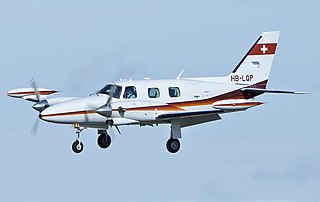
The Piper PA-31T Cheyenne is a turboprop development of the earlier PA-31P Pressurized Navajo.

The Cessna 421 Golden Eagle is an American six or seven seat twin-engined light transport aircraft, developed in the 1960s by Cessna as a pressurized version of the earlier Cessna 411.

The Cessna 414 is an American light, pressurized, twin-engine transport aircraft built by Cessna. It first flew in 1968 and an improved variant was introduced from 1978 as the 414A Chancellor.

The Cessna Model 404 Titan is an American twin-engined, light aircraft built by Cessna Aircraft. It was the company's largest twin piston-engined aircraft at the time of its development in the 1970s. Its US military designation is C-28, and Swedish Air Force designation Tp 87.

The Beechcraft Model 99 is a civilian aircraft produced by Beechcraft. It is also known as the Beech 99 Airliner and the Commuter 99. The 99 is a twin-engine, unpressurized, 15 to 17 passenger seat turboprop aircraft, derived from the earlier Beechcraft King Air and Queen Air. It uses the wings of the Queen Air, the engines and nacelles of the King Air, and sub-systems from both, with a specifically designed nose structure.

The Beechcraft Queen Air is a twin-engined light aircraft produced by Beechcraft in numerous versions from 1960 to 1978. Based upon the Twin Bonanza, with which it shared key components such as wings, engines, and tail surfaces, it had a larger fuselage, and served as the basis for the highly successful King Air series of turboprop aircraft. Its primary uses have been as a private aircraft, utility, and small commuter airliner. Production ran for 17 years.
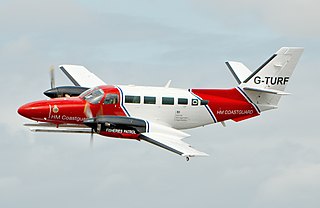
The Reims-Cessna F406 Caravan II is a turboprop twin engine utility aircraft manufactured and designed by Reims Aviation in cooperation with Cessna.

The Cessna 340 is a twin piston engine pressurized business aircraft that was manufactured by Cessna.

The Cessna Model 411 is an American twin-engined, propeller-driven, pressurized light aircraft built by Cessna Aircraft. It was that company's largest business aircraft to enter production when it first flew in 1962.

The Fuji T-5 or KM-2Kai is a Japanese turboprop-driven primary trainer aircraft, which is a development of the earlier Fuji KM-2. The student and the instructor sit side-by-side.
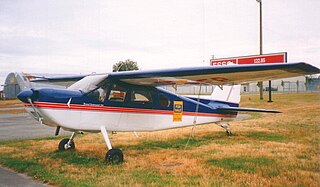
The Found Centennial 100 is a Canadian six-seat cabin monoplane produced by Found Brothers Aviation.

The Swearingen Merlin or the Fairchild Aerospace Merlin is a pressurized, twin turboprop business aircraft first produced by Swearingen Aircraft, and later by Fairchild at a plant in San Antonio, Texas.
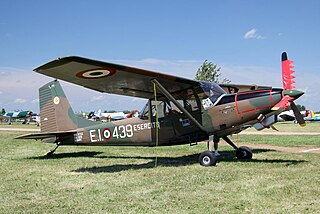
The SIAI-Marchetti SM.1019 is an Italian STOL liaison monoplane built by SIAI-Marchetti for the Italian Army. It is a turboprop-powered derivative of the Cessna O-1 Bird Dog.
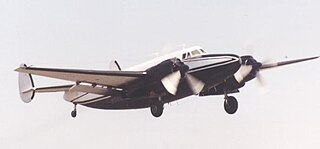
The Howard 500 is an American executive transport aircraft produced by Howard Aero Incorporated during the early 1960s.





















